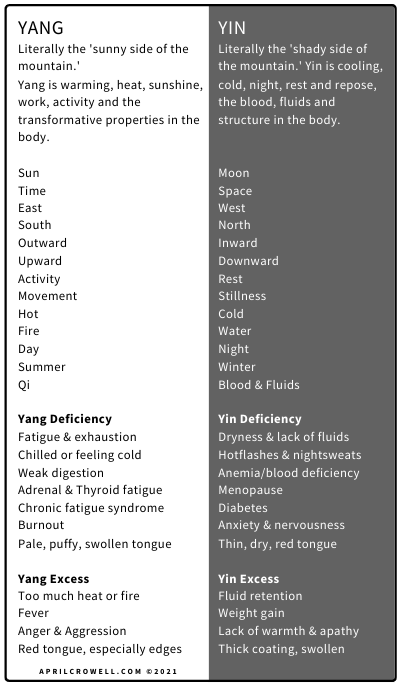Yin & Yang – Understanding Opposites
The principles of Yin and Yang, a foundational theory of Asian medicine, is both profound and very simplistic. The two represent the dynamic opposites seen all throughout nature. They are not viewed as absolutes, but rather identified by their characteristics relative to the other. In other words, you cannot identify if something is Yin without knowing something is Yang. Asian medicine practitioners then use the understandings of these qualities and their relationship to each other to identify and treat disharmony. When Yin and Yang are balanced there is harmony, it’s when they move out of balance that problems arise in the body or in the world.
A Little History
The earliest reference to Yin and Yang theory is generally regarded to come from the Book of Changes or the I Ching around 700 BC. It is very likely that the theory was passed down orally for hundreds of years prior. The I Ching represented Yin and Yang by a series of lines and broken lines that would later evolve to become the 8 trigrams or the Bagua, which then gives rise to the 64 hexagrams.
Ba Gua
The 64 hexagrams symbolizes all possible phenomenon in the universe. From 476-221 BC, The Yin/Yang or Naturalist School devoted its studies and trained scholars in the identification of Qi, Yin and Yang the 5 Element theory. It set out to interpret nature in a positive way and to use natural laws to man’s advantage specifically for ruling and political purposes. The goal wasn’t to attempt to control nature, rather it was to learn how to create harmony with man and nature, creating balance, relieving suffering and opportunity for growth and prosperity. Eventually, these theories would become foundational in the Neo-Confucianism schools during the Song, Ming and Qing dynasties. These school further evolved and elaborated on the theories applying them to nature, ethics, social order and astrology. What evolved is a vast network of interactions and observations that are still the foundation of Chinese medicine and life philosophies.
This chart depicts the evolution of the characters for Yin and Yang, moving from the oldest on top to the most contemporary on the bottom.
Yin (left) means the shady side of the mountain.
Yang (right) means the sunny side of the mountain.
The Qualities of Yin and Yang
The qualities of Yin – The character for Yin literally translates as the shady side of the mountain. The qualities of Yin are cooling, rich, quiet, dense, solid, deep and dark. It is quiescence, stillness and rest. Yin nourishes and replenishes. In the body, the Yin organs rule over the blood and fluids.
The qualities of Yang – Literally, the sunny side of the mountain. Yang qualities represent heat, action, movement, growth, and bright. It is activity and in the body and the Yang organs rule over the creation of energy, transformation, fire and heat in the body.
Again, Yin and Yang are relative concepts and are identified by comparing it to its opposite…..eh? They are qualities that identified by knowing the other. The sun is Yang (bright, hot, active) compared to the earth (cooler, moister, quieter). However, if we compare the earth to the moon, the earth is Yang while the moon is Yin as is it more quiet and more still than the earth–get it?
Before we delve further let’s look at some general opposites.
When orienting to direction, we should note that Asian cultures orient to the south. The emperor, as the child of heaven, always faced the south when greeting his subjects, so when applying Yin and Yang to the body, directions or maps, it is based on the emperor facing south.
Yin and Yang Rules — Yin and Yang have several rules that they abide by.
They create each other—Yin and Yang are constantly flowing from one to the other. When Yang reaches maximum at noon on the summer solstice, it immediately starts to show the influence of Yin as we then start to move back towards autumn. The next day is slightly shorter….more Yin.
They control each other—Each relies on the other to keep it in check. We rely on having enough Yin in the evening to allow us to rest from the day’s long activity. Too little Yin and we may experience anxiety, restlessness, and hot flashes in the evening–all possible signs that Yin is depleted.
They are opposites, yet compliment each other—Yin & Yang are opposite but complementary qualities. Each thing or phenomenon can be itself or its contrary. Yin contains the seed of Yang and vise versa. Another example — If we compare hot and cold water, hot water is Yang and cold water Yin. But if you compare hot water to steam the hot water becomes Yin relative to the steam which would be more Yang as it is less material and more active.
They transform into each other— Yin moves to maximum and transforms into Yang. This happens through changes that either occur harmoniously in the normal course of events or through some ruptures and transformations that are characteristic of extremely disharmonious situations. Inhalation is followed by exhalation. At the boiling point water becomes steam and has tremendous power (Yang). Freezing point Water becomes ice (Yin) Another example is the seasons. Spring: Yang within Yin, the growth of Yang. We then flow into Summer, which reaches maximum Yang at the summer solstice before turning towards Yin again.
The chart depicts the general states of imbalance for reference. It is very common for both Yin and Yang to be out of balance at the same time. For example - a very high fever with a virus is an excess of Yang. Over time the excess Yang will deplete Yin. We treat the acute first - clearing the fever - in this case.
Yin/Yang are relative concepts—Take the three qualities of energies of fire, water, and wood. Fire is the Yang in relationship to water and earth. Earth is Yin in relationship to fire and water. Water is Yang to earth, and Yin to fire. Most Yang—Fire/ water/ wood/ earth/ metal– Most Yin. Get it?
Asian medicine understands that the universe is continuously changing. The cosmos is an integral whole, a web of interrelated things within which an entity can be defined by its function and has significance only as a part of the whole.
Yin and Yang theory is first basic theory of Asian medicine. From here, we can further refine and define our assessment and treatment principles. At the very basic level I teach my students to break everything down to Yin and Yang, no matter how complex the person’s pathology, it will always give a foundation to start with.
How we use this theory to treat — I could lecture on them all day long. In fact, I have, for whole weekends to practitioners, or for a few hours to curious clients. Teaching this concept to teens is really fun. The steps for treating when Yin and Yang are out of balance is truly straightforward. If there is deficiency we increase. If there is excess we decrease. Recommendations would cover foods and herbs to include or reduce, and activities to decrease or increase for the desired therapeutic goal.
Yin excess — weight gain, phlegm, fluid retention, we increase Yang to warm and transform dampness.
Yang excess — fever, high blood pressure, heat, we increase Yin foods and habits to cool.
Yin deficiency — dryness, anemia, lack of fluids, we nourish Yin with foods and herbs and removing overly drying foods, etc.
Yang deficiency —fatigue, lack of energy, weak immunity. We warm and tonify Yang.
It is not uncommon to see mixed patterns. Yin excess and Yang deficiency, etc. Treatment is always to treat the acute first (this would be a cold, flu, recent ‘attack’ of some sort), then treat the dominant imbalance first, while clearing phlegm/damp and to regulate. Get it?
Be well,
April










